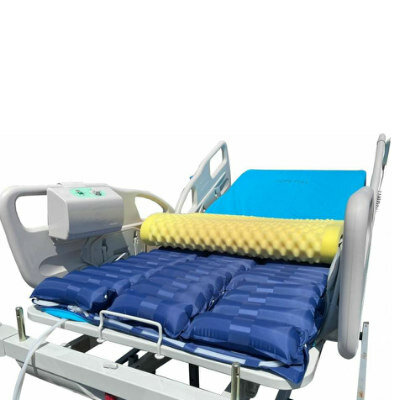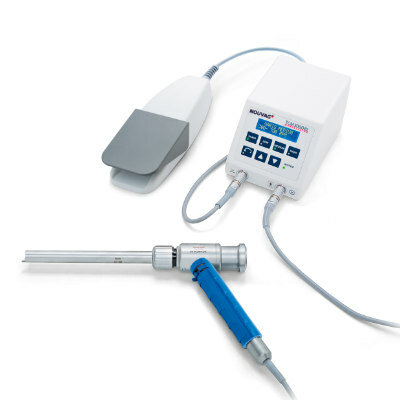Full Spectrum Endoscopy Detects Significantly More Polyps 
|
By HospiMedica International staff writers Posted on 31 Mar 2014 |

Image: The EndoCoice Fuse system control panel (Photo courtesy of Endochoice).
A pivotal comparison study shows that full spectrum endoscopy dramatically outperforms standard forward-viewing colonoscopy (SFV).
Researchers at the Rambam Health Care Campus (Haifa, Israel) conducted an international randomized trial in Israel, the Netherlands, and the USA involving 185 participants (18–70 years of age) referred for colorectal cancer screening, polyp surveillance, or diagnostic assessment. The patients underwent same-day, back-to-back tandem colonoscopy; 48% were randomly assigned to receive SFV first, and 52% to receive full-spectrum colonoscopy with the EndoChoice Fuse System colonoscope first. The primary endpoint was adenoma miss rates.
The results showed that by per-lesion analysis, the adenoma miss rate was significantly lower in patients in the full-spectrum endoscopy group (7%) than in those in the SFV procedure group (41%). Full-spectrum endoscopy missed 5 adenomas in 5 patients in whom an adenoma had already been detected with first-pass SFV; none of these missed adenomas that were advanced. SFV, on the other hand, missed 20 adenomas in 15 patients; of those, 3 were advanced adenomas. Five minor adverse events were reported including vomiting, diarrhoea, cystitis, gastroenteritis, and bleeding. The study was published in the March 2014 issue of the Lancet Oncology.
“As the gold standard for colorectal cancer screening, standard forward-viewing colonoscopy still misses a significant percentage of precancerous polyps due to inadequate visualization of the many folds and bends of the colon,” said lead author Ian Gralnek, MD, of the Rambam department of gastroenterology. “These study results confirm that Fuse is an important technological advancement in colorectal cancer screening that significantly improves visualization and has the potential to improve screening outcomes for many patients.”
“The results of this study support our greatest priority as physicians, which is to miss fewer precancerous polyps and improve the quality of our colonoscopies,” added Dr. Gralnek. “It is important for doctors and their patients to know the Fuse endoscopy platform is now available and has the ability to significantly increase adenoma detection rates.”
For the study the researchers used the EndoChoice (Atlanta, GA, USA) Fuse system, which uses three small cameras at the tip of a flexible gastrointestinal endoscope. By using three cameras, the system allows physicians to see nearly twice as much surface area as they can with traditional endoscopes, since the wider angles allow examination of folds that occur naturally in the colon and stomach anatomy, problem areas that can easily go undetected when using traditional one-camera endoscopes.
Related Links:
Rambam Health Care Campus
EndoChoice
Researchers at the Rambam Health Care Campus (Haifa, Israel) conducted an international randomized trial in Israel, the Netherlands, and the USA involving 185 participants (18–70 years of age) referred for colorectal cancer screening, polyp surveillance, or diagnostic assessment. The patients underwent same-day, back-to-back tandem colonoscopy; 48% were randomly assigned to receive SFV first, and 52% to receive full-spectrum colonoscopy with the EndoChoice Fuse System colonoscope first. The primary endpoint was adenoma miss rates.
The results showed that by per-lesion analysis, the adenoma miss rate was significantly lower in patients in the full-spectrum endoscopy group (7%) than in those in the SFV procedure group (41%). Full-spectrum endoscopy missed 5 adenomas in 5 patients in whom an adenoma had already been detected with first-pass SFV; none of these missed adenomas that were advanced. SFV, on the other hand, missed 20 adenomas in 15 patients; of those, 3 were advanced adenomas. Five minor adverse events were reported including vomiting, diarrhoea, cystitis, gastroenteritis, and bleeding. The study was published in the March 2014 issue of the Lancet Oncology.
“As the gold standard for colorectal cancer screening, standard forward-viewing colonoscopy still misses a significant percentage of precancerous polyps due to inadequate visualization of the many folds and bends of the colon,” said lead author Ian Gralnek, MD, of the Rambam department of gastroenterology. “These study results confirm that Fuse is an important technological advancement in colorectal cancer screening that significantly improves visualization and has the potential to improve screening outcomes for many patients.”
“The results of this study support our greatest priority as physicians, which is to miss fewer precancerous polyps and improve the quality of our colonoscopies,” added Dr. Gralnek. “It is important for doctors and their patients to know the Fuse endoscopy platform is now available and has the ability to significantly increase adenoma detection rates.”
For the study the researchers used the EndoChoice (Atlanta, GA, USA) Fuse system, which uses three small cameras at the tip of a flexible gastrointestinal endoscope. By using three cameras, the system allows physicians to see nearly twice as much surface area as they can with traditional endoscopes, since the wider angles allow examination of folds that occur naturally in the colon and stomach anatomy, problem areas that can easily go undetected when using traditional one-camera endoscopes.
Related Links:
Rambam Health Care Campus
EndoChoice
Latest Surgical Techniques News
- Hydrogel-Based Miniaturized Electric Generators to Power Biomedical Devices
- Custom 3D-Printed Orthopedic Implants Transform Joint Replacement Surgery
- Wearable Technology Monitors and Analyzes Surgeons' Posture during Long Surgical Procedures
- Cutting-Edge Imaging Platform Detects Residual Breast Cancer Missed During Lumpectomy Surgery
- Computational Models Predict Heart Valve Leakage in Children
- Breakthrough Device Enables Clear and Real-Time Visual Guidance for Effective Cardiovascular Interventions
- World’s First Microscopic Probe to Revolutionize Early Cancer Diagnosis
- World’s Smallest Implantable Brain Stimulator Demonstrated in Human Patient

- Robotically Assisted Lung Transplants Could Soon Become a Reality
- AI to Provide Heart Transplant Surgeons with New Decision-Making Data
- New Surgical Tool Empowers Precision and Confidence in Operating Room
- Future Muscle-Powered Surgical Robots Could Perform Minimally Invasive Procedures inside Body
- Non-Invasive Technique Combines Cardiac CT with AI-Powered Blood Flow for Heart Bypass Surgery
- First-Of-Its-Kind Device Repairs Leaky Tricuspid Heart Valve
- New Signaling Method Enables Precise Localization of Miniature Robots and Surgical Instruments inside Body
- Novel Catheter System Enables Safer, More Cost-Effective Transseptal Procedures
Channels
Artificial Intelligence
view channel
AI-Powered Algorithm to Revolutionize Detection of Atrial Fibrillation
Atrial fibrillation (AFib), a condition characterized by an irregular and often rapid heart rate, is linked to increased risks of stroke and heart failure. This is because the irregular heartbeat in AFib... Read more
AI Diagnostic Tool Accurately Detects Valvular Disorders Often Missed by Doctors
Doctors generally use stethoscopes to listen for the characteristic lub-dub sounds made by heart valves opening and closing. They also listen for less prominent sounds that indicate problems with these valves.... Read moreCritical Care
view channel
Deep-Learning Model Predicts Arrhythmia 30 Minutes before Onset
Atrial fibrillation, the most common type of cardiac arrhythmia worldwide, affected approximately 59 million people in 2019. Characterized by an irregular and often rapid heart rate, atrial fibrillation... Read more
Breakthrough Technology Combines Detection and Treatment of Nerve-Related Disorders in Single Procedure
The peripheral nervous system (PNS) serves as the communication network that links the brain and spinal cord to every other part of the body. It consists of two parts: the somatic nervous system, which... Read morePatient Care
view channel
Surgical Capacity Optimization Solution Helps Hospitals Boost OR Utilization
An innovative solution has the capability to transform surgical capacity utilization by targeting the root cause of surgical block time inefficiencies. Fujitsu Limited’s (Tokyo, Japan) Surgical Capacity... Read more
Game-Changing Innovation in Surgical Instrument Sterilization Significantly Improves OR Throughput
A groundbreaking innovation enables hospitals to significantly improve instrument processing time and throughput in operating rooms (ORs) and sterile processing departments. Turbett Surgical, Inc.... Read more
Next Gen ICU Bed to Help Address Complex Critical Care Needs
As the critical care environment becomes increasingly demanding and complex due to evolving hospital needs, there is a pressing requirement for innovations that can facilitate patient recovery.... Read moreGroundbreaking AI-Powered UV-C Disinfection Technology Redefines Infection Control Landscape
Healthcare-associated infection (HCAI) is a widespread complication in healthcare management, posing a significant health risk due to its potential to increase patient morbidity and mortality, prolong... Read moreHealth IT
view channel
Machine Learning Model Improves Mortality Risk Prediction for Cardiac Surgery Patients
Machine learning algorithms have been deployed to create predictive models in various medical fields, with some demonstrating improved outcomes compared to their standard-of-care counterparts.... Read more
Strategic Collaboration to Develop and Integrate Generative AI into Healthcare
Top industry experts have underscored the immediate requirement for healthcare systems and hospitals to respond to severe cost and margin pressures. Close to half of U.S. hospitals ended 2022 in the red... Read more
AI-Enabled Operating Rooms Solution Helps Hospitals Maximize Utilization and Unlock Capacity
For healthcare organizations, optimizing operating room (OR) utilization during prime time hours is a complex challenge. Surgeons and clinics face difficulties in finding available slots for booking cases,... Read more
AI Predicts Pancreatic Cancer Three Years before Diagnosis from Patients’ Medical Records
Screening for common cancers like breast, cervix, and prostate cancer relies on relatively simple and highly effective techniques, such as mammograms, Pap smears, and blood tests. These methods have revolutionized... Read morePoint of Care
view channel
Critical Bleeding Management System to Help Hospitals Further Standardize Viscoelastic Testing
Surgical procedures are often accompanied by significant blood loss and the subsequent high likelihood of the need for allogeneic blood transfusions. These transfusions, while critical, are linked to various... Read more
Point of Care HIV Test Enables Early Infection Diagnosis for Infants
Early diagnosis and initiation of treatment are crucial for the survival of infants infected with HIV (human immunodeficiency virus). Without treatment, approximately 50% of infants who acquire HIV during... Read more
Whole Blood Rapid Test Aids Assessment of Concussion at Patient's Bedside
In the United States annually, approximately five million individuals seek emergency department care for traumatic brain injuries (TBIs), yet over half of those suspecting a concussion may never get it checked.... Read more
New Generation Glucose Hospital Meter System Ensures Accurate, Interference-Free and Safe Use
A new generation glucose hospital meter system now comes with several features that make hospital glucose testing easier and more secure while continuing to offer accuracy, freedom from interference, and... Read moreBusiness
view channel
Johnson & Johnson Acquires Cardiovascular Medical Device Company Shockwave Medical
Johnson & Johnson (New Brunswick, N.J., USA) and Shockwave Medical (Santa Clara, CA, USA) have entered into a definitive agreement under which Johnson & Johnson will acquire all of Shockwave’s... Read more
















